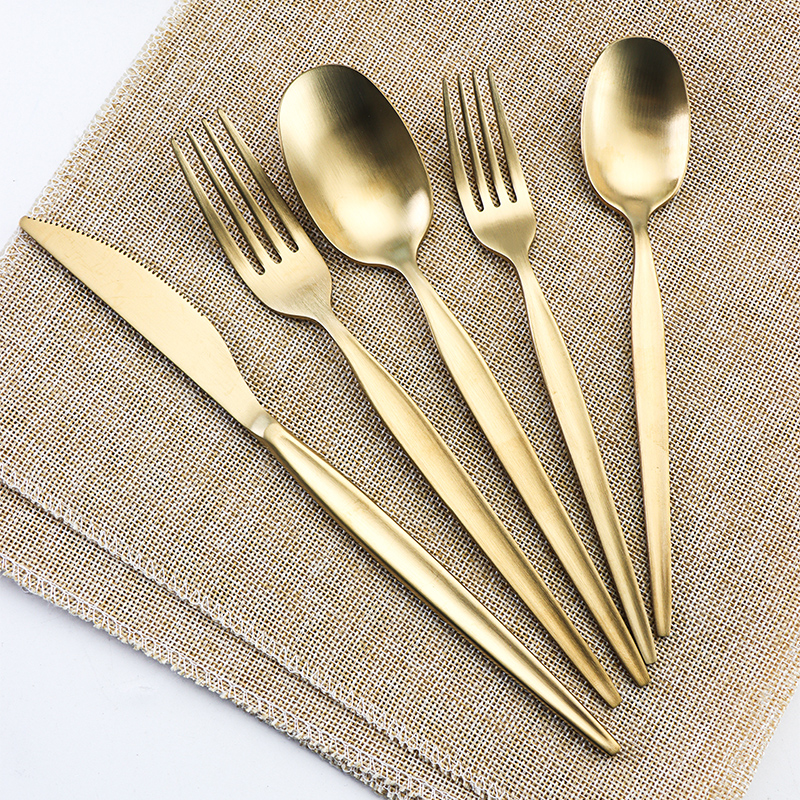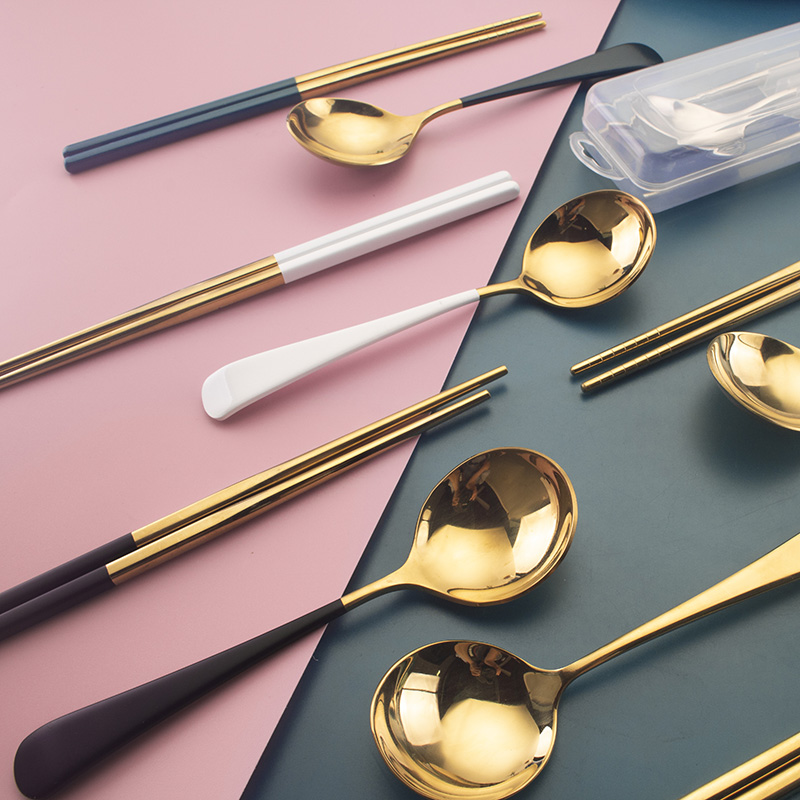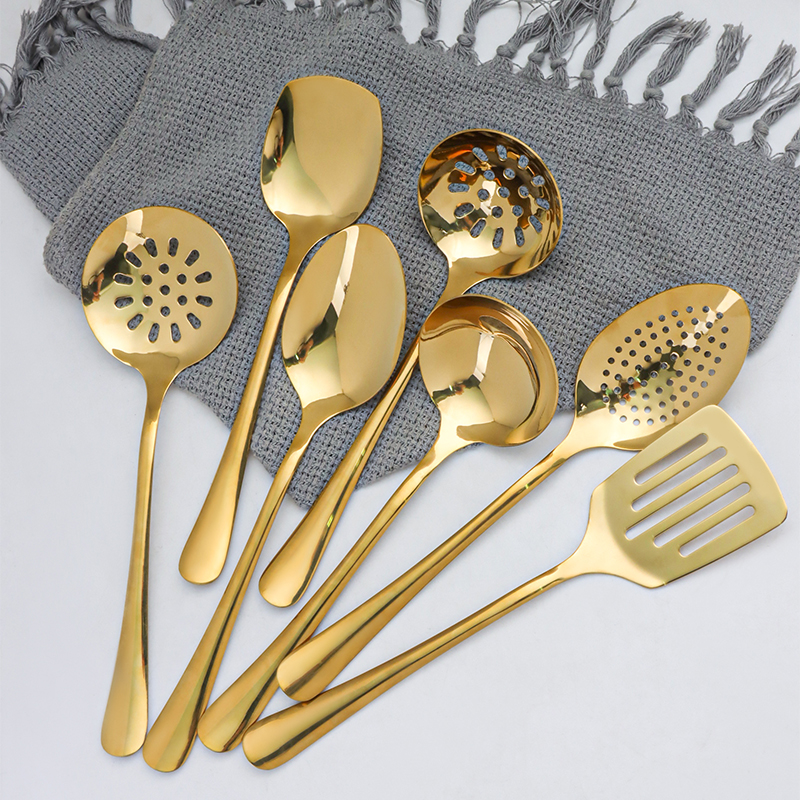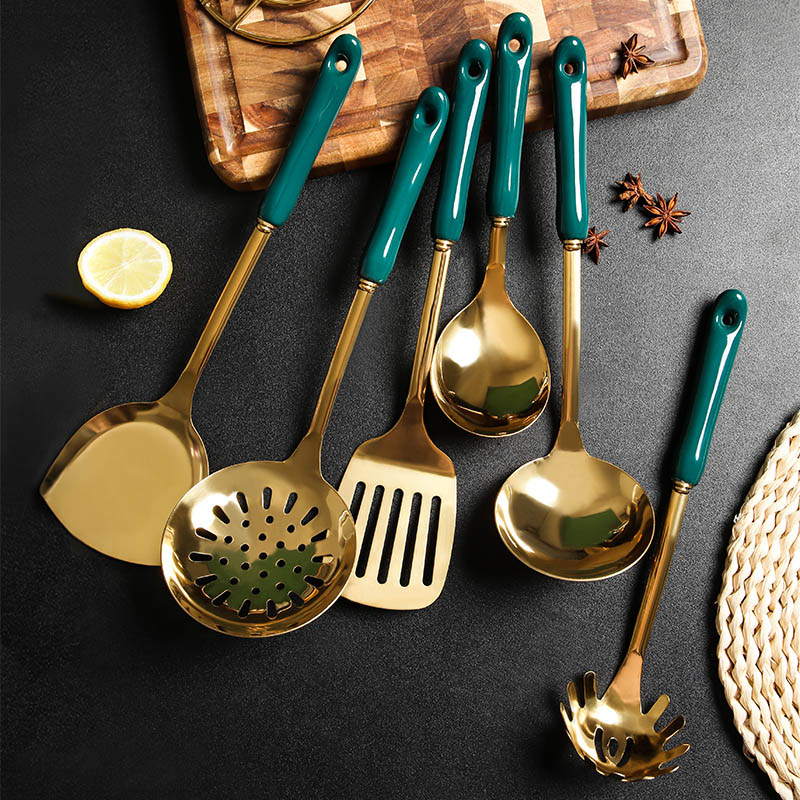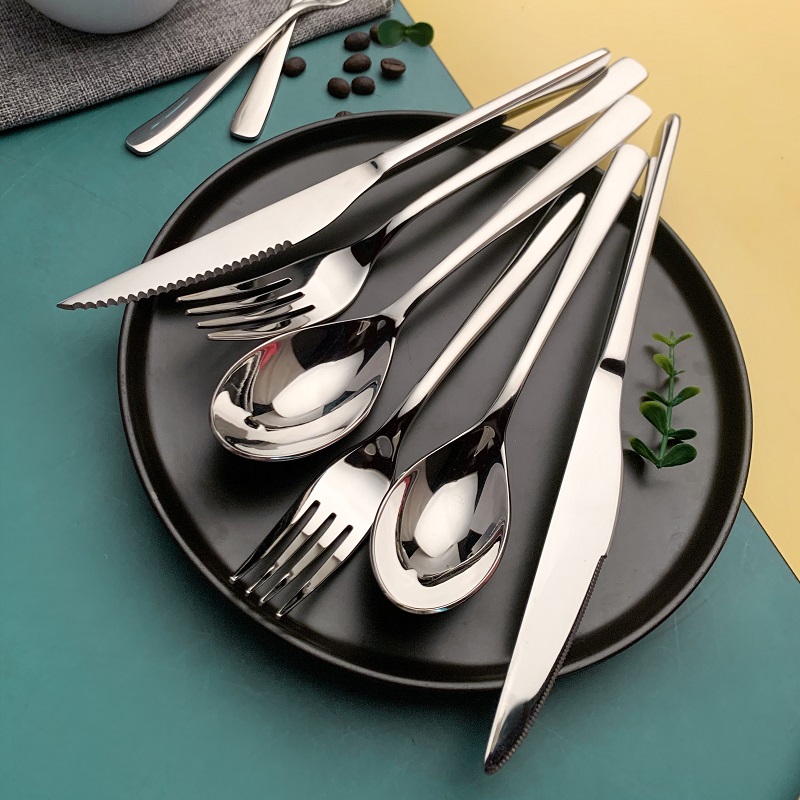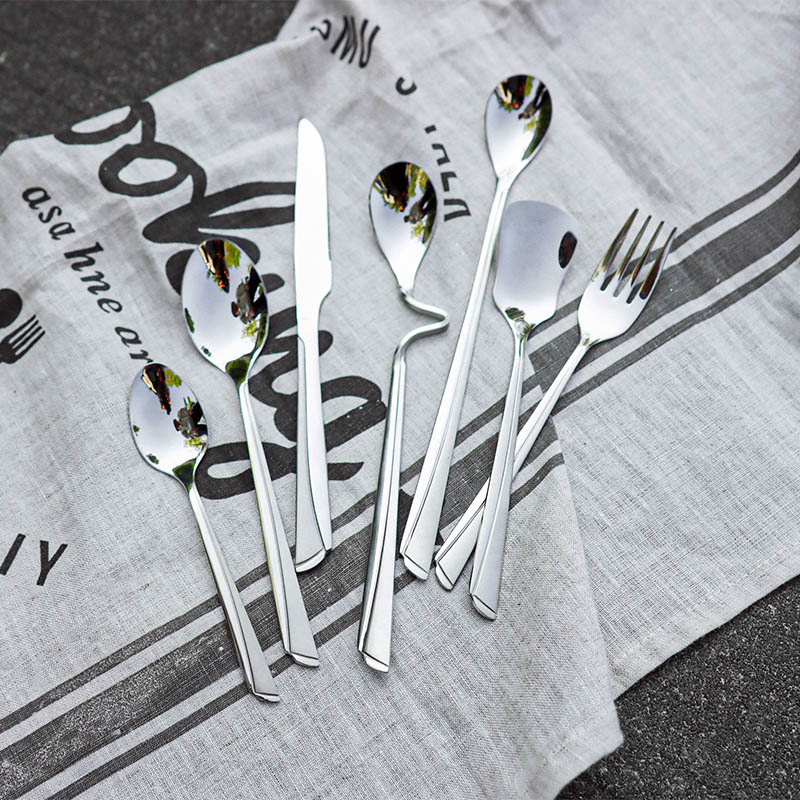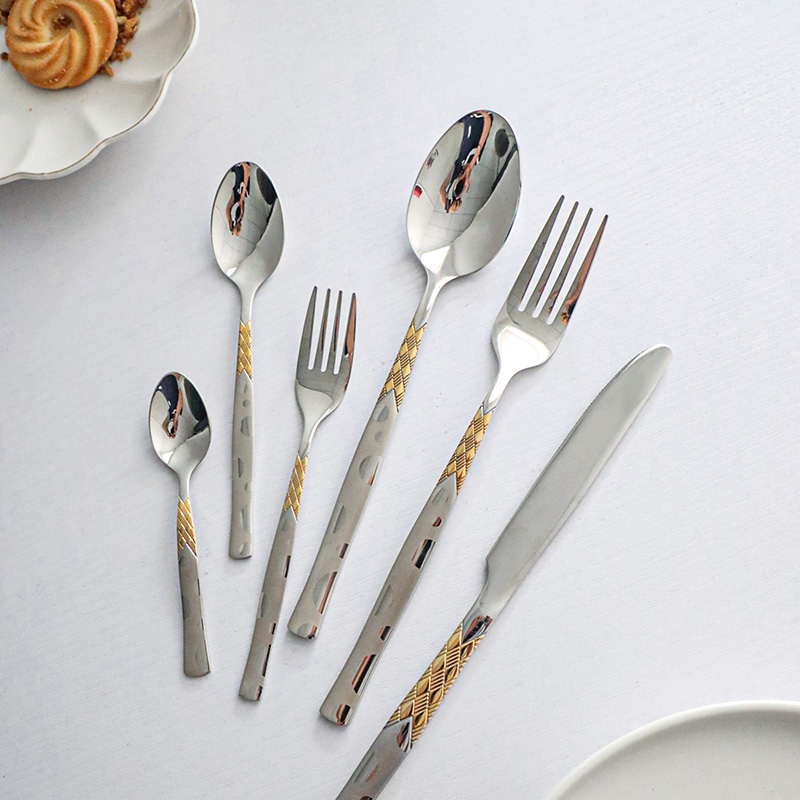Оптовая продажа золотых столовых приборов
Discover wholesale gold cutlery direct from the factory. Explore a variety of styles, customizable options, and unbeatable prices. Elevate your dining experience with our premium collection. Order now!
Top categories
С 1993 года
ЦЯНЬСИНЬ Столовые приборы
Компания Jieyang Qianxin Stainless Steel Products Co., Ltd. была основана в 1993 г. и имеет более чем 25-летний опыт производства и поставки столовых приборов, кухонной утвари и посуды. Компания занимает площадь 6000 кв. м, располагает современным оборудованием и сотнями сотрудников. Мы ориентируемся на зарубежные рынки, включая Европу, Северную Америку и Ближний Восток. Мы предлагаем OEM и ODM услуги для наших клиентов ...

About Gold Cutlery
Types of Gold Cutlery
Gold cutlery is typically crafted from metals of a higher grade than conventional options and is then plated with gold to create a luxurious and opulent appearance. Below are some common varieties of gold cutlery:
- Stainless Steel with Gold Plating:
This is a widely used material for cutlery, including gold-plated options. Gold-plated stainless steel cutlery is produced by electroplating a thin layer of gold onto stainless steel. The process begins with thoroughly cleaning the stainless steel to eliminate any impurities. Following this, gold is deposited onto the stainless steel through an electrochemical process. Stainless steel, which contains chromium, is known for its rust and corrosion resistance, ensuring that gold-plated stainless steel cutlery is both durable and long-lasting while exuding a luxurious finish.
- Titanium with Gold Plating:
Cutlery made from titanium and adorned with gold plating is lightweight and robust, with an elegant exterior. Titanium is a strong, lightweight metal frequently employed in various applications, including cutlery. The gold plating is applied to titanium cutlery via the same electrochemical process as other gold plating methods. Initially, the titanium surface is cleaned and prepared, after which a thin layer of gold is deposited. Titanium cutlery boasts impressive corrosion resistance and a unique, luxurious aesthetic thanks to the gold finish.
- Brass with Gold Plating:
Brass cutlery, which features a gold-plated coating, is crafted from an alloy of copper and zinc. This material offers good corrosion resistance and possesses antimicrobial properties, making it suitable for cutlery and other food-contact applications. The process for producing brass cutlery with gold plating involves shaping the brass into the desired cutlery form, followed by cleaning, polishing, and applying a thin layer of gold through electroplating.
- Metal and Resin Gold Cutlery:
Metal and resin gold cutlery is an innovative type that combines metal and resin materials, enhanced by a gold decorative element. In this type of cutlery, metal is typically used for the blades and tips of knives and forks to ensure strength and durability, while resin is employed for the handles and decorative components. The resin can be tailored in terms of colour, texture, and design, allowing for a unique and artistic presentation. Gold can be incorporated in various ways, such as gold plating on metal parts or mixing gold powder into the resin to achieve a luxurious appearance.
Designs of Gold Cutlery
Gold cutlery is available in a myriad of designs, ranging from traditional to contemporary. Each design can be customised to align with specific styles or themes, making gold cutlery a versatile and elegant choice for any occasion.
- Engraved Design:
Engraved gold cutlery sets feature intricate designs or patterns etched into the surface of the utensils. These patterns can vary from simple monograms to elaborate floral or geometric motifs, adding a touch of sophistication and personalisation to the table setting.
- Vintage Design:
Vintage gold cutlery sets draw inspiration from the styles of bygone eras, such as the Victorian or Art Deco periods. These sets often showcase ornate details, including intricate patterns, filigree work, and decorative elements on the handles or blades of knives, forks, and spoons. Some may even incorporate gemstones or other luxurious materials to elevate the overall opulence of the tableware.
- Minimalistic Design:
Gold cutlery sets with a minimalistic design emphasise simplicity and clean lines, resulting in a sleek, modern appearance. These sets typically feature understated details, with smooth and unembellished surfaces for the handles and blades. The absence of ornate decorations lends these utensils a contemporary and refined aesthetic, making them ideal for modern dining settings.
- Floral Design:
Floral gold cutlery sets incorporate botanical elements into their design, often showcasing flower motifs or patterns. These sets may feature handles adorned with engravings, carvings, or prints of various flowers, infusing the dining experience with a touch of natural beauty and elegance.
- Geometric Design:
Geometric gold cutlery sets are characterised by clean lines, sharp angles, and symmetrical shapes, resulting in a sleek and modern aesthetic. Handles often display angular patterns or shapes, imparting a stylish and contemporary flair.
- Ornate Design:
Ornate gold cutlery sets exhibit intricate details and embellishments, such as floral patterns, scrollwork, or other decorative elements. These sets showcase elaborate craftsmanship, with finely crafted designs on the handles and blades, adding a sense of luxury and sophistication to the dining experience.
- Royal Design:
Royal gold cutlery sets are distinguished by their grand and opulent designs, often featuring intricate details and embellishments. These sets may showcase heavy, ornate handles adorned with elaborate patterns, scrollwork, or even gemstones. The overall effect is one of luxury and sophistication, creating an atmosphere suitable for a regal or lavish dining experience.
Gold cutlery is renowned for its exceptional properties and finds applications in a multitude of industries.
Scenarios for Gold Cutlery
Gold cutlery can play a significant role in various special occasions. For formal events such as wedding receptions, gala dinners, or milestone anniversary celebrations, using gold cutlery can add an element of opulence and create lasting memories. It is particularly suited for serving special dishes, such as caviar or gourmet desserts.
During holiday feasts, gold cutlery enhances the dining experience at Christmas dinners or Thanksgiving lunches, infusing the atmosphere with festivity and luxury. Additionally, in the jewelry industry, gold is frequently employed as a primary material for crafting intricate rings, necklaces, and bracelets, where its brilliance and tarnish resistance make it ideal for everyday wear. Gold also features prominently in creating decorative elements and inlaying gemstones within larger jewelry pieces.
How to Choose Gold Cutlery
- Purpose and Usage:
When selecting gold cutlery, it is essential to consider its intended use. If the cutlery is to be used on a daily basis, opting for a more durable material, such as stainless steel with gold plating, may be prudent. Conversely, if the cutlery is intended for special occasions or decorative settings, pure gold cutlery could be a suitable choice.
- Material Options:
Gold cutlery typically comes in two primary forms: stainless steel with gold plating and stainless steel with a gold alloy coating. Gold plating involves a thin layer of gold electrochemically deposited onto the surface of another metal, while a gold alloy coating provides enhanced durability through a stronger bond with the underlying material.
- Durability vs. Aesthetics:
If durability is a priority, stainless steel with a gold alloy coating is likely the better option. However, if aesthetics take precedence and the user is willing to invest extra care in maintenance, gold-plated alternatives may suffice for less frequent use.
- Maintenance:
Regardless of the chosen material, gold cutlery should ideally be hand-washed to preserve its finish. Users should ensure the cutlery is dried immediately after washing to avoid water spots.
- Design and Style:
Gold cutlery is available in a range of designs, from classical ornate patterns to sleek modern lines. Users should select a design that not only reflects their personal style but also complements their existing tableware.
- Budget:
It is important to consider the budget, as there can be a significant price difference between gold-plated and gold alloy-coated cutlery. Pure gold cutlery commands a premium due to the materials involved.
Q&A
Q1: Is gold cutlery safe to use?
A1: Yes, gold cutlery is safe to use. Gold is a biocompatible metal, meaning it does not react with foods or beverages. This quality makes it an ideal material for medical applications, such as prosthetics and dental work. However, if an individual has allergies to gold or other metals present in the cutlery, it is advisable to avoid its use.
Q2: Can gold cutlery be used daily?
A2: Yes, gold cutlery can indeed be used daily. Many gold cutlery pieces are crafted from stainless steel, which offers durability and resistance to rust and corrosion, with a thin layer of gold applied to the handles or the entire utensil. This makes them suitable for everyday use. However, gold cutlery is generally more expensive than standard utensils. To maintain their luster and prevent excessive wear, it is wise to clean them properly after each use and consider reserving them for special occasions.
Q3: How should gold cutlery be cleaned?
A3: To clean gold cutlery, it is essential to avoid harsh chemicals or abrasive sponges that could damage the gold layer. Instead, wash the cutlery with mild soap and warm water. Rinse thoroughly, and then dry with a soft cloth to maintain its shine and prevent water spots.
Q4: Is gold cutlery worth the investment?
A4: Gold cutlery can be a worthy investment, particularly if one values aesthetics and luxury in dining experiences. Its durability, combined with its ability to elevate the presentation of meals, makes it a desirable addition to any table setting. Furthermore, the long-lasting quality of gold cutlery means that, with proper care, it can serve for many years.
Q5: Are there different grades of gold cutlery?
A5: Yes, gold cutlery can vary in quality based on the thickness of the gold plating and the underlying material used. The most common types are gold-plated stainless steel and gold alloy-coated stainless steel. The latter tends to be more durable due to a stronger bond between the gold and the base metal.


